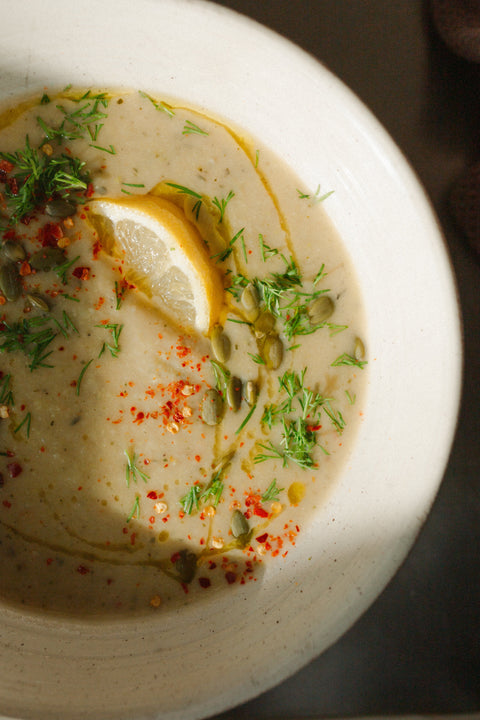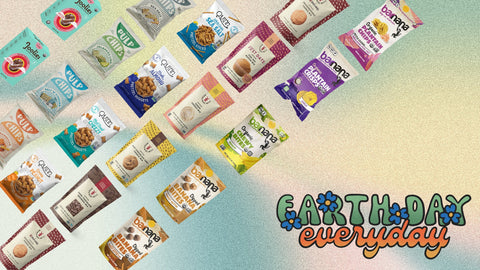
It's Food Waste Prevention Week!
And we're coming in hot with a soupy recipe that will utilize all of your vegetable stalks and stems. In this case.... we used the stalks and stems of romanesco to create this delicious soup. You could adapt this recipe to use cauliflower stems, broccoli stems, you name it. You could even add the stems of your favorite herbs!
Soups (and especially blended soups) make it insanely easy to put those stems and stalks to use. Don't waste them - there's so much nutrition left behind in stalks and stems.
Vegetable stems like broccoli stems contain a similar nutritional profile to the florets, and are a good source of several essential nutrients. Such as:
- Fiber: Broccoli stems are a good source of dietary fiber, which is important for digestive health and can help with weight management. Fiber can also help lower cholesterol levels and regulate blood sugar levels.
- Vitamins and Minerals: Broccoli stems, for example, are rich in vitamins and minerals, including vitamin C, vitamin K, vitamin B6, and potassium. Vitamin C is an antioxidant that helps boost the immune system and supports collagen production. Vitamin K is important for blood clotting and bone health. Vitamin B6 is involved in many physiological processes, including metabolism and brain development. Potassium is an essential mineral that helps regulate blood pressure and fluid balance.
- Antioxidants: those vegetable stems contain antioxidants such as beta-carotene, lutein, and zeaxanthin. These antioxidants can help protect cells from damage caused by free radicals and may have anti-inflammatory properties.
- Protein (though a smaller amount)
- Low in Calories: Broccoli stems are relatively low in calories, making them a good option for those who are watching their calorie intake. This can be helpful for weight management and overall health.
To make the most of the nutrition in broccoli stems, you can peel off the tough outer layer and chop the softer inner part into smaller pieces for cooking. They can be used in a variety of ways, such as stir-frying, sautéing, roasting, or adding to soups or stews like this recipe will show you how to do.
Romanesco Broccoli and Potato soup
Ingredients
- 1 tbsp olive oil
- 1 yellow onion, diced
- 4 cloves garlic, minced
- 1 large romanesco broccoli, chopped with leaves and stem
- 1 russet potato, washed and chopped
- 1 tsp thyme
- 1/4 c nutritional yeast
- 1 can full fat coconut milk
- 1.5 cups vegetable broth
- 1 tbsp miso
- 1 tsp apple cider vinegar
- juice of half a lemon
- salt and pepper
- 1 tsp chili flakes (optional)
Instructions
- Heat a larger pot over medium heat. Sauté the onions and garlic until golden. Add potato and romanesco (stems and leaves included). Add salt and pepper and a splash of water and cover for a minute or so to let everything steam.
- Add the thyme and nutritional yeast and give it a stir. Pour in coconut milk followed by veg broth. Bring to a low boil then simmer with the lid askew for about 20 minutes until everything is tender.
- Add the miso, apple cider vinegar and lemon juice and stir. Using an immersion blender or high speed blender blitz the soup to your desired consistency. I like to keep mine a little chunky. Taste and adjust seasonings if necessary.
- Top with fresh dill, pepitas, chili flakes, and a lemon wedge. Eat immediately.
Notes
- Broccoli can also be used instead of romanesco for this recipe.
- IMPORTANT: I have noticed that the outer skin of the romanesco and broccoli stems is quite tough so I will slice the outer skin off to incorporate the stems in the soup.
Romanesco Broccoli and Potato soup
Ingredients
- 1 tbsp olive oil
- 1 yellow onion, diced
- 4 cloves garlic, minced
- 1 large romanesco broccoli, chopped with leaves and stem
- 1 russet potato, washed and chopped
- 1 tsp thyme
- 1/4 c nutritional yeast
- 1 can full fat coconut milk
- 1.5 cups vegetable broth
- 1 tbsp miso
- 1 tsp apple cider vinegar
- juice of half a lemon
- salt and pepper
- 1 tsp chili flakes (optional)
Instructions
- Heat a larger pot over medium heat. Sauté the onions and garlic until golden. Add potato and romanesco (stems and leaves included). Add salt and pepper and a splash of water and cover for a minute or so to let everything steam.
- Add the thyme and nutritional yeast and give it a stir. Pour in coconut milk followed by veg broth. Bring to a low boil then simmer with the lid askew for about 20 minutes until everything is tender.
- Add the miso, apple cider vinegar and lemon juice and stir. Using an immersion blender or high speed blender blitz the soup to your desired consistency. I like to keep mine a little chunky. Taste and adjust seasonings if necessary.
- Top with fresh dill, pepitas, chili flakes, and a lemon wedge. Eat immediately.
Notes
- Broccoli can also be used instead of romanesco for this recipe.
- IMPORTANT: I have noticed that the outer skin of the romanesco and broccoli stems is quite tough so I will slice the outer skin off to incorporate the stems in the soup.
Enjoy!
About Food Waste & Food Waste Prevention Week
Why is saving food from going to waste so important?
Reducing food waste is the #1 action YOU can take to reduce greenhouse gas emissions. When food is wasted, it goes into a landfill. Once in a landfill, food waste breaks down and emits greenhouse gasses, including carbon dioxide (CO2) and methane (CH4). Methane is 30 times more potent than carbon dioxide, making it more damaging to the environment. So fighting food waste = fighting climate change.
Not motivated by the climate impacts of wasted food?
Well, what if we told you you're losing a TON of money each year on waste food? In fact, each American household wastes an estimated $1,600 annually on purchased food that never goes eaten!
Households are responsible for the most wasted food. If we begin to reduce and prevent food waste, we can save that money that is wasted on spoiled food.
According to Food Waste Prevention Week, every year, Americans lose more than $218 billion on wasted food.
Learn more via https://www.foodwastepreventionweek.com/about-us





